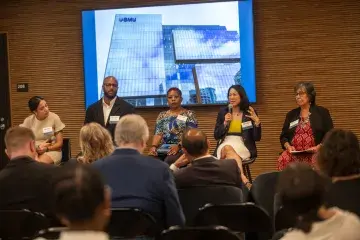Q&A with Dr. Sharon Gorman: Why Women’s Sports Medicine Deserves the Spotlight and How SMU is Helping Lead the Way

On June 7, 2025, the Oakland Coliseum will host Soul of the Bay, its first-ever women’s professional sports event. It’s a landmark moment for the stadium and a powerful step forward for women in sports. But for those of us in healthcare and education, it’s also a reminder that equity in athletics has to carry through to the care we provide.
As Chair of the Physical Therapy Department at Samuel Merritt University, Dr. Sharon Gorman has spent over two decades training the next generation of physical therapists to think critically about equity, inclusion and evidence-based care. Ahead of the landmark event, we spoke with Dr. Gorman about why women’s sports medicine matters and how SMU is helping shape a more equitable future for athletes and the clinicians who care for them.
SMU has a long-standing commitment to health equity. How does supporting women’s sports, and women’s sports medicine, fit into that mission?
A lot of the research in sports medicine has traditionally been very male-focused. But women are not men, we’re different. We have different metabolisms, different body structures and different biomechanical inputs. Those differences might not matter much when you’re just walking down the street, but once you’re jumping, cutting or colliding, they become a big deal. They influence everything from injury risk to how effective a treatment will be. At SMU, part of our commitment to equity is making sure our students understand those distinctions so they can provide truly individualized, evidence-based care.
Why is there a need for a specialized focus on women’s sports medicine?
Because women athletes still don’t get the same level of attention, resources or care. That’s true in training, in pay, in facilities and in healthcare. Even at the same level of competition, male athletes often have better access to rehab, specialized training and comprehensive medical teams. And yet we know female athletes face unique risks. For example, ACL injuries are much more common among women, especially in sports like soccer. That’s partly due to anatomy, but also training styles. With the right preventative strategies, including strengthening and movement retraining, we can reduce those risks. But we need to pay attention first. That’s why a focused approach matters.
How does SMU prepare students to support female athletes across different stages of life?
At SMU, we take a lifespan-based approach. We talk about adolescent athletes, adult athletes and how physical therapy needs to adapt depending on where someone is in life and in their sport. We talk about gender-based differences, how sports are played differently across genders and what that means for injury patterns or treatment goals. We also offer a sports medicine elective with dedicated sessions on female athletes, because we recognize how important that knowledge is. And all of this is layered over a curriculum that’s deeply committed to equity, whether we’re talking about gender, race, socioeconomic status or structural barriers in healthcare.
How do community events like Soul of the Bay help advance clinical practice and public awareness?
Events like Soul of the Bay are critical. Every athlete on that field started somewhere. And I think we have a responsibility, not just as clinicians, but as community members, to ask: Are young girls getting the same training and medical support early on so they can stay healthy and injury-free? There is no reason female athletes should be injuring themselves if there are clear steps we can take to prevent it. Whether they become pros or just play for fun, they deserve care that protects their bodies.
What’s the role of academic institutions like SMU in creating a more equitable future for women in sports?
At SMU, we intentionally recruit students who care about transforming lives, especially in underserved communities. Throughout their education, we’re challenging them to think critically: What don’t we know? What have we assumed? How do race, gender and lived experience shape a person’s health and how can we adjust our care accordingly? That’s true for athletes, too. We want our students to understand that you can’t treat everyone the same and expect the same results. Equity requires nuance, curiosity and a willingness to question the norm.
Any final thoughts heading into this historic event?
I’m incredibly proud that SMU is part of this moment. We’ve always believed in the power of movement to heal, to empower and to connect, and women’s sports is such a powerful example of that. Supporting these athletes and their fans means supporting healthier communities, and that’s exactly what we’re here to do.


